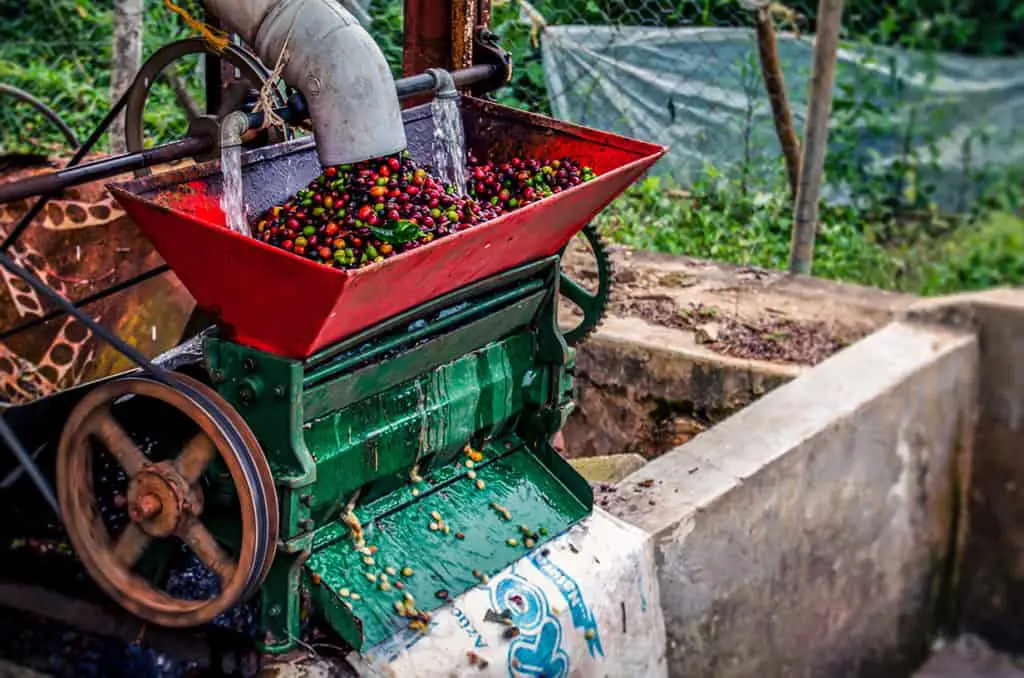
If you’ve ever visited Costa Rica, the unforgettable taste of its coffee likely still in your memory. For those yet to experience it, you’re in for a treat. This small Central American country produces some of the world’s finest Arabica coffee, renowned for its sweet, lively acidity and complex flavors. From the unique plant varieties and high-altitude growing regions to innovative processing methods, Costa Rican coffee stands out as a global favorite.
Let’s discover why Costa Rican coffee is considered the best, learn about its history, explore its growing regions, and find tips for brewing and buying authentic beans.
The Beginning of Coffee in Costa Rica

Costa Rica is celebrated for its stunning landscapes—mountain ranges, conical volcanoes, pristine beaches, equatorial climate, and dense jungles—but its coffee is a true gem. Known as the “grano de oro” (golden grain), Costa Rican coffee offers sweet, crisp flavors reminiscent of fresh green apples.
Coffee arrived in Costa Rica in 1779 from Cuba, with commercial production starting in 1808 and exports by 1820. By the 1820s, Costa Rica became the first Central American country with a fully-fledged coffee industry, thanks to government incentives like free land and tax exemptions.
Coffee quickly surpassed cocoa, sugar, and tobacco to become the nation’s top export, funding infrastructure like the National Theatre in San José (1897) and the Atlantic railway (1890). Today, coffee remains the third-largest agricultural export after bananas and pineapples, with $372 million in exports in 2022/23, despite producing just 0.7–1% of global coffee.
Costa Rica also gifted the world the honey processing method, a hybrid between washed and natural processes that balances sweetness and clarity. We’ll explore this innovation later, but it’s one of many reasons Costa Rican coffee is exceptional.
Why Is Costa Rican Coffee the Best?
Coffee enthusiasts often ask, “What makes Costa Rican coffee so special?” The answer lies in a combination of natural advantages and human ingenuity:
- Volcanic Soil: Nutrient-rich volcanic soil, especially in Tarrazú and the Central Valley, fosters complex flavors.
- High Altitudes: Most coffee grows at 800–2,000 meters above sea level, where slower ripening enhances acidity and sweetness.
- Arabica-Only Policy: Since 1989, Costa Rica banned Robusta to maintain quality, focusing on Arabica varieties like Caturra and Catuaí. (In 2018, Robusta was permitted in warmer regions to adapt to climate change, but Arabica dominates.)
- Sustainable Practices: Shade-grown coffee, drip irrigation, and water-efficient processing align with Costa Rica’s 93% renewable energy production.
- Innovative Processing: The honey processing method, pioneered in Costa Rica, creates unique flavor profiles.
These factors, overseen by the Instituto del Café de Costa Rica (ICAFE), ensure consistently high-quality coffee that’s won numerous Cup of Excellence awards.
What are the Coffee Growing Regions of Costa Rica?
Costa Rica’s eight coffee-growing regions, clustered in the country’s central highlands, produce distinct flavors due to unique altitudes, soils, and microclimates. The table below summarizes each region’s key characteristics, from the world-renowned Tarrazú to the historic Orosi, helping you find a coffee that suits your taste.
| Region | Altitude (masl) | Flavor Profile | Production Share | Notable Characteristics |
|---|---|---|---|---|
| Tarrazú | 1,200–2,000 | Floral, vanilla, cocoa, orange, caramel | ~30% | World-renowned, vibrant acidity, mostly washed coffees, stunning views during growing season |
| West Central Valley | 1,200–1,700 | Chocolate, honey, peach, apricot, tropical fruits | 25% | High percentage of Cup of Excellence winners, known for honey and natural processed coffees |
| Central Valley | 1,000–1,200 | Caramel, citrus, sweet, fragrant | 15% | Robust flavors, grown in tropical volcanic soil, close to San José |
| Brunca | 800–1,700 | Soft at lower altitudes; orange, jasmine at higher | 20% | Third-largest producer, diverse altitudes, complex flavors in higher areas |
| Tres Ríos | Up to 1,650 | Orange zest, stone fruits, honey, balanced | ~5% | Small region, dubbed “Costa Rica’s Bordeaux,” near Irazú Volcano |
| Turrialba | Up to 1,400 | Delicate, light body, mild acidity, smoky | ~3% | Wettest region, multiple harvests, large cherries, volcanic ash influence |
| Orosi | 1,000–1,400 | Cocoa, vibrant sweetness, silky smooth | ~2% | One of the oldest regions, high humidity, nutrient-rich volcanic soil |
| Guanacaste | 600–1,300 | Bitter, salty, soft | ~2% | Shade-grown, small producers, warmer climate, less desirable for specialty coffee |
Coffee Varieties in Costa Rica
Costa Rica exclusively grows Coffea Arabica, with a 1989 law banning Robusta to uphold quality standards. Common varieties include:
- Caturra: Bright acidity, medium body, with citrus, chocolate, and apricot notes (~90% of production with Catuaí).
- Catuaí: Delicate sweetness, tropical fruit flavors.
- Bourbon: Rich, sweet, often grown at higher altitudes.
- Typica: Balanced, smooth, historically significant.
- Villa Sarchi: A Costa Rican Bourbon mutation, thriving in volcanic soils with complex flavors.
- Geisha: Rare, floral, with jasmine and tropical fruit notes.
- SL-28: Experimental, typically Kenyan, with bold flavors.
Rarer varieties like Peaberry are also emerging among specialty producers.
Costa Rican Coffee Processing

Coffee harvesting in Costa Rica is labor-intensive, done by hand during the dry season (December–April). Ripe cherries are picked, sorted, and processed using three main methods:
Washed Coffee
Washed coffees, common in Tarrazú, produce clean, transparent flavors. After de-pulping, the mucilage is removed through 12–72 hours of fermentation, followed by rinsing and drying to 11% moisture. These coffees highlight the bean’s intrinsic flavors without fruit influence.
Natural Processed Coffee
Natural (dry) processing, used in lower-altitude regions, dries the whole cherry, imparting tropical fruit flavors like pineapple and jackfruit. It requires careful monitoring to avoid over-fermentation, which can yield boozy, undesirable notes. Drying occurs on patios or raised beds, sometimes with mechanical dryers.
Honey Processed Coffee
Costa Rica pioneered the honey processing method in 2006, a hybrid balancing washed clarity with natural sweetness. After de-pulping, varying amounts of mucilage (“honey”) are left on the bean:
- White Honey: 80–100% mucilage removed, closest to washed.
- Yellow Honey: 50–75% mucilage removed.
- Red Honey: 0–50% mucilage removed, darker and sweeter.
- Black Honey: Minimal mucilage removed, intensely fruity.
Honey processing is riskier due to potential molding but yields high-value coffees.
Coffee Drying
Post-processing, coffee is dried on concrete patios, raised African beds, or in mechanical dryers to reach 11% moisture. Techniques like piling beans into mounds slow drying, enhancing flavor complexity.
Terroir in Costa Rica
Terroir—soil, altitude, and climate—shapes Costa Rican coffee’s flavor. Volcanic soil provides nutrients, ideal for demanding varieties like Geisha. The climate, with distinct wet (growing) and dry (harvesting) seasons, supports optimal growth at 18–24°C. High altitudes (800–2,000 masl) slow cherry ripening, developing complex sugars. However, climate change is disrupting flowering cycles, posing challenges.
Sustainability in Coffee Production
Costa Rica leads in sustainable coffee farming. Shade-grown coffee promotes biodiversity, while drip irrigation and water-efficient micro-mills reduce environmental impact. The country’s 93% renewable energy production supports eco-friendly processing. ICAFE regulates quality and researches sustainable practices, ensuring coffee farming aligns with Costa Rica’s environmental ethos.
Coffee Tourism in Costa Rica
Coffee tourism is a highlight for visitors. Guided tours at Hacienda Alsacia (Starbucks’ farm), La Minita in Tarrazú, or family-run farms in the Central Valley offer insights into cultivation, harvesting, and processing. Many include tastings, chocolate-making, or sugarcane experiences. Coffee fairs in San José or Heredia during winter showcase the culture, making Costa Rica a must-visit for coffee lovers.
Modern Challenges
Despite its success, Costa Rica’s coffee industry faces challenges. Real estate development, particularly in the Central Valley, competes for farmland, reducing coffee acreage. Climate change disrupts flowering and increases pest risks. However, the rise of micro-mills and specialty coffee allows producers to focus on high-quality, small-batch beans, fetching premium prices.
How to Brew Costa Rican Coffee
Brew Costa Rican coffee with a French Press, Chemex, or Aeropress for great results, but for authenticity, use a chorreador (sock). This traditional method involves pouring hot water through ground coffee in a cloth filter suspended in a wooden frame, producing a smooth, rich cup. Called “aguas de medias” (sock water), it’s a cultural staple in Costa Rican homes. Try it for a taste of tradition!
Buying Costa Rican Coffee
Whether you’re across the globe or dreaming of Costa Rica’s vibrant flavors, sourcing authentic Costa Rican coffee is easier than ever. For the best experience, choose single-origin, whole-bean coffee roasted close to your order date to ensure freshness. Here’s how to get your hands on premium Costa Rican beans from anywhere in the world:
Online Retailers:
Major platforms like Amazon, Walmart, and specialty coffee sites (e.g., Sweet Maria’s, Coffee Bean Direct) offer a wide selection of Costa Rican coffees. Look for brands like Café Britt, a household name with Tarrazú and Tres Ríos options, or Aquiares Estate, known for bright, complex Caturra and Catuaí. These sites often provide worldwide shipping, though costs vary by region.
Direct from Producers:
Many Costa Rican farms and co-operatives sell directly through their websites, ensuring traceability and freshness. La Minita (Tarrazú) and Monte Crisol (West Central Valley) offer online stores with high-quality Arabica beans, often shipped to North America, Europe, and beyond. Check shipping policies, as costs can be higher for distant regions.
Specialty Coffee Retailers:
International roasters like Blue Bottle (U.S.), Square Mile Coffee (UK), or The Coffee Collective (Denmark) frequently stock Costa Rican beans, especially from Tarrazú or West Central Valley. These retailers prioritize freshness and often include tasting notes to guide your choice.
Subscription Services:
Coffee subscription services like Trade Coffee, Bean Box, or Atlas Coffee Club deliver freshly roasted Costa Rican coffee to your door, often with customizable options. These are ideal for discovering new beans from regions like Tres Ríos or Orosi, with shipping available in many countries.
Tips for International Buyers:
Compare shipping costs and delivery times, as they can vary significantly (e.g., $10–$30 for U.S., higher for Asia). Opt for vacuum-sealed or recently roasted beans to maintain flavor during transit. Avoid blends to experience pure Costa Rican profiles and check for certifications like Fair Trade or Rainforest Alliance for ethical sourcing.
By exploring these options, you can try Costa Rica’s world-class coffee no matter where you are. Support small producers when possible to contribute to the country’s coffee culture.
NOTE: When buying coffee try to buy coffee try to get whole bean and that has been roasted as close to your order date as possible.
Final Thought
Costa Rican coffee’s exceptional quality stems from its volcanic terroir, high-altitude Arabica varieties, and innovative processing like the honey method. Supported by sustainable practices and a rich cultural heritage, it’s no wonder coffee from regions like Tarrazú and Tres Ríos is celebrated globally. Whether brewing with a chorreador or visiting a plantation, Costa Rican coffee offers a taste of paradise in every cup.

